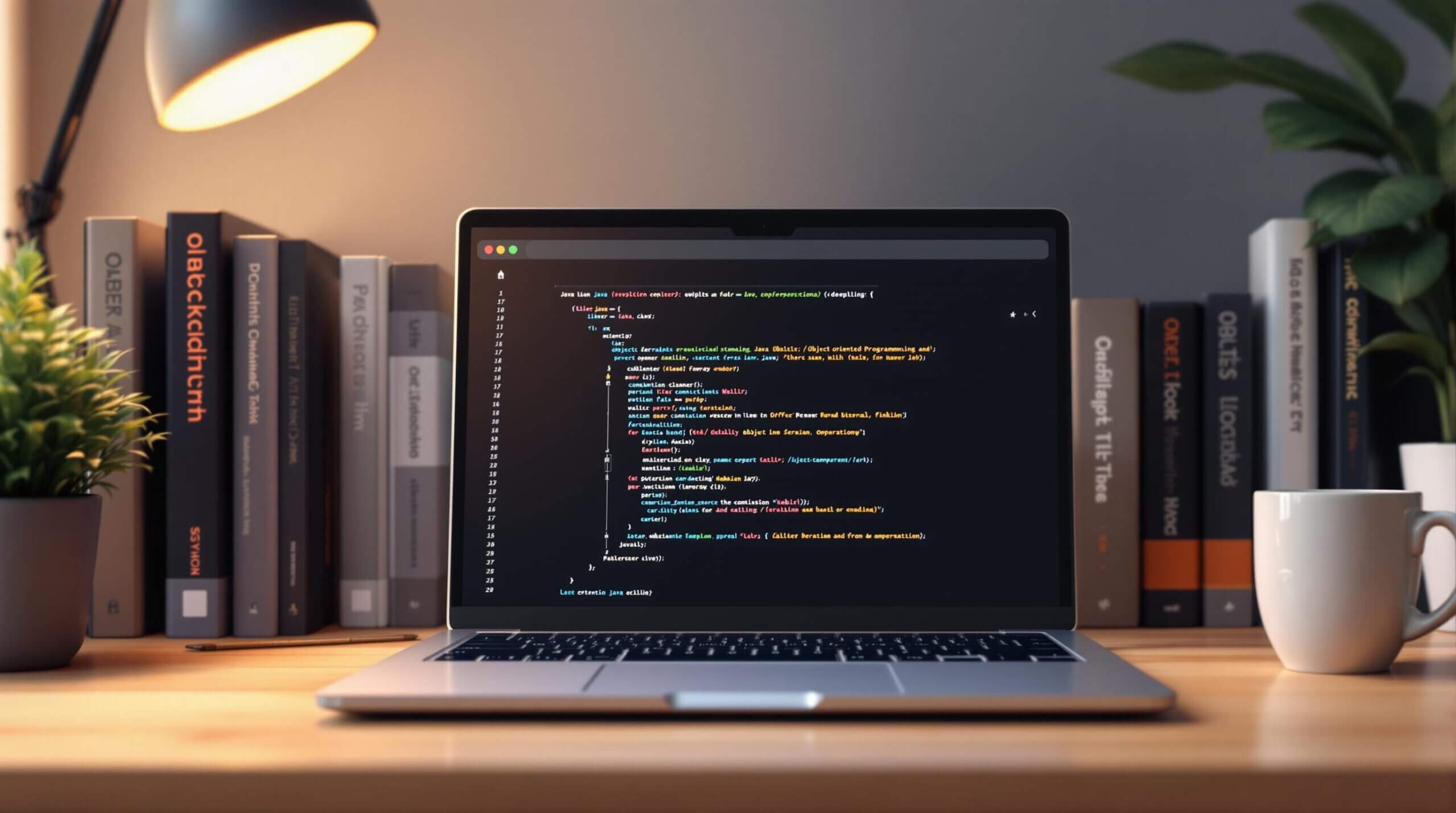Java Full Stack Development is about mastering both front-end and back-end technologies to build complete web applications. This guide covers everything you need to know:
- Core Java Skills: Learn OOP principles, exception handling, collections, and multithreading.
- Front-End Tools: Use HTML, CSS, JavaScript, and frameworks like React or Angular for user-friendly designs.
- Back-End Frameworks: Spring Boot simplifies REST API creation and integrates databases seamlessly.
- Database Management: Understand schema design, query optimization, and tools like MySQL.
- Learning Path: Structure your journey with clear phases – from Java basics to full-stack projects.
With hands-on projects and resources like KodNest or Coursera, you can gain job-ready skills and build a portfolio to showcase your expertise. Full-stack development offers growing career opportunities in industries like e-commerce, finance, and healthcare. Ready to dive in? Let’s get started!
Full Stack Development with Java Spring Boot, React, and MongoDB

Skills and Tools for Java Full Stack Development
To excel as a Java Full Stack Developer, it’s important to have expertise in both front-end and back-end technologies. Here’s a breakdown of the key skills and tools you’ll need.
Learning Core Java
A solid understanding of Java fundamentals is critical for building reliable applications. Focus on these core concepts:
| Core Concept | Application | Business Impact |
|---|---|---|
| OOP Principles | Modular and reusable code | Speeds up development |
| Exception Handling | Error-resistant applications | Boosts reliability |
| Collections Framework | Efficient data management | Enhances performance |
| Multithreading | Concurrent operations | Improves responsiveness |
Once you’re comfortable with Java basics, you’ll be ready to tackle front-end technologies to craft engaging user interfaces.
Front-End Development Basics
Java Full Stack Developers must know how to build responsive and user-friendly interfaces.
- HTML/CSS: These are the building blocks of web apps, enabling structure and styling. Tools like Bootstrap help create responsive designs quickly.
- JavaScript: Adds dynamic functionality to the client side, using features like DOM manipulation and modern syntax.
- Frameworks: React and Angular are powerful tools for creating advanced UIs. They provide:
- Component-based structures for better code organization
- Efficient data binding
- Pre-built components to speed up development
Once you’ve mastered front-end development, it’s time to focus on back-end frameworks like Spring Boot.
Using Spring Boot for Back-End Development
Spring Boot is a go-to framework for Java back-end development. It simplifies the process with features like auto-configuration, built-in servers, and easy REST API creation.
By integrating Spring Data JPA, developers can focus more on business logic instead of repetitive code, making it an ideal choice for enterprise-level applications.
Working with Databases
Database management plays a crucial role in full-stack development. Here’s what you need to know:
- Database Integration: Tools like JDBC and Spring Data JPA streamline Java-database interactions, making tasks like queries and transactions more efficient.
- Schema Design: A well-designed database ensures smooth performance. Key practices include:
- Normalization for better data organization
- Index optimization for faster queries
- Tuning query performance
- Managing data relationships effectively
The Java Learning Center offers a training program for ₹26,000, covering these essential skills with hands-on exercises [1]. This equips developers to build and manage enterprise-grade applications with confidence.
Learning Path and Resources
Here’s how to structure your learning journey to become proficient in Java Full Stack Development.
Step-by-Step Guide to Learning
| Phase | Duration | Focus Areas |
|---|---|---|
| Foundation | 4-6 weeks | Core Java, OOP concepts |
| Front-End | 8 weeks | HTML/CSS, JavaScript, React/Angular |
| Back-End | 12 weeks | Spring Boot, REST APIs |
| Database | 4 weeks | Database management with MySQL |
| Integration | 4 weeks | Full-stack project development |
This roadmap helps you focus on one area at a time, ensuring steady progress.
Resources and Practical Learning
The right resources can make a big difference in mastering full-stack development. Some popular platforms provide structured programs tailored to this field:
- KodNest’s Full Stack Development program: Offers AI-driven mentorship and hands-on projects. Offline training costs ₹31,999, while online training is priced at ₹26,999 [4].
- Coursera’s Java FullStack Developer Specialization: A flexible program that maintains a structured curriculum for learners [4].
To get the most out of your training:
- Dedicate 50% of your time to coding.
- Focus on creating applications, managing databases, and building APIs to develop real-world skills.
- Aim to complete 3-4 major projects during your training, as these provide practical experience [2][4].
Hands-on learning is essential. It not only strengthens your understanding but also prepares you for real-world scenarios – something we’ll dive into in the next section.
sbb-itb-f454395
Creating Projects to Build Skills
After mastering the basics, the next step in becoming proficient in Java Full Stack Development is applying your knowledge through hands-on projects.
Project Ideas for Practice
Start with projects that gradually increase in complexity:
| Project Type | Technologies | Key Features |
|---|---|---|
| Blog Platform | Spring Boot + React | User authentication, CRUD operations, comments |
| E-commerce Site | Java + Angular + MySQL | Product catalog, shopping cart, payment system |
| Customer Management | Spring Boot + React + APIs | Contact tracking, reporting, data analytics |
These projects should incorporate databases, APIs, and responsive design to demonstrate your full-stack skills. Using the right tools can simplify your workflow and improve your project outcomes.
Tools for Building Projects
Here are some essential tools to consider for your development process:
| Tool Category | Recommended Options | Purpose |
|---|---|---|
| IDE | IntelliJ IDEA, Eclipse | Writing and debugging code |
| Version Control | GitHub, GitLab | Managing and sharing code |
| Build Tools | Maven | Handling dependencies |
| Testing | JUnit, Mockito | Unit and integration testing |
Pick tools with strong community support and detailed documentation. IntelliJ IDEA is especially popular for Java developers due to its advanced features and ease of use [2].
Presenting Projects to Employers
To make your projects stand out to potential employers, focus on:
- Highlighting challenges solved and technologies used: Be specific about the problems your project addresses and the tools you employed.
- Demonstrating organization and best practices: Show clean code, thorough testing, and attention to security.
- Providing measurable outcomes: Include metrics like improved performance or user engagement.
Keep your projects on GitHub with a polished repository that includes:
- A clear project architecture overview
- Step-by-step installation instructions
- A list of technologies used
- Detailed feature descriptions
- Suggestions for future enhancements
These projects not only sharpen your skills but also create a professional portfolio to showcase during job applications.
Career Growth and Job Support
A career in Java Full Stack Development is becoming increasingly attractive as the demand for developers skilled in both frontend and backend technologies continues to rise.
Preparing for Interviews
Java Full Stack Developer interviews focus on both theoretical knowledge and practical skills. Here’s what employers typically evaluate:
| Interview Component | Focus Areas | Preparation Tips |
|---|---|---|
| Technical Assessment | Core Java, Spring Boot, Data Structures | Use coding platforms to sharpen problem-solving skills |
| System Design | Architecture patterns, Scalability | Study system design fundamentals and best practices |
| Frontend Skills | Angular/React, REST APIs | Create projects that showcase API integration and UI design |
| Problem Solving | Algorithm optimization, Debugging | Practice troubleshooting through real-world projects |
Technical preparation is key, but structured training programs can also help candidates secure roles more effectively.
Leveraging Training Programs with Job Support
Programs like KodNest’s offer structured pathways to success. Their ₹31,999 offline program includes AI-driven mentorship, hands-on projects, mock interviews, and unlimited placement support. The ₹26,999 online version provides the same benefits remotely [4].
Staying Updated with New Skills
Java Full Stack Development is a fast-evolving field. To stay relevant, focus on these areas:
- Cloud Computing: Master deployment techniques for platforms like AWS, Azure, or Google Cloud.
- Microservices Architecture: Learn about distributed systems, containerization, and their applications.
- AI Integration: Explore AI-powered tools and frameworks for development.
To stay ahead, developers should actively participate in workshops, join developer communities, and contribute to open-source projects.
Most positions in this field require an IT degree or equivalent, along with 3-5 years of experience [5]. Keeping up with emerging trends not only enhances job prospects but also prepares developers for leadership roles in the tech industry [3].
Continuous learning is the key to thriving in this ever-changing field.
Summary and Final Thoughts
Java Full Stack Development offers a career path that combines expertise in both front-end and back-end technologies. Companies like Ben & Jerry’s are actively seeking developers skilled in end-to-end application development, focusing on core Java, Spring Boot, modern front-end frameworks, and database management systems [5].
Training programs are tailored to equip developers with both technical knowledge and hands-on experience. Key areas of focus include:
| Development Area | Core Technologies | Industry Applications |
|---|---|---|
| Front-end | Angular/React | Building interactive user interfaces |
| Back-end | Java, Spring Boot | Developing business logic and APIs |
| Database | MySQL | Managing and storing data |
| Cloud Integration | AWS, Azure | Enabling scalable deployment solutions |
Developers are tasked with creating scalable, efficient applications that meet the needs of modern businesses [3]. This requires an in-depth understanding of technical concepts and their application in practical, real-world scenarios.
New trends like cloud integration and digital transformation are reshaping how applications are designed and deployed. To succeed in this field, developers should focus on:
- Strengthening their technical foundation with targeted learning
- Gaining hands-on experience through real-world projects
- Staying updated with emerging technologies and industry shifts
As companies continue to embrace digital transformation, the demand for Java Full Stack Developers remains robust. The ability to deliver end-to-end solutions that seamlessly connect user-friendly front-end designs with powerful back-end systems makes this role essential in today’s tech-driven environment [3].
FAQs
Which Java full-stack course is best?
Here are some well-regarded options based on industry feedback and student outcomes:
| Course Platform | Program Name | Key Features |
|---|---|---|
| Coursera | IBM Full Stack Software Developer Certificate | Certification, hands-on labs |
| LinkedIn Learning | Become a Full-Stack Web Developer | Project-based learning, expert-led |
| Udemy | The Complete 2024 Web Development Bootcamp | Broad curriculum, regular updates |
When picking a course, focus on these important factors:
- Curriculum and Format: Look for a program that thoroughly covers essential technologies and fits your schedule, whether it’s self-paced or an intensive bootcamp [1].
- Employer Recognition: Opt for courses offering certifications that are respected in the job market [4].
Many of these courses emphasize project-based learning, enabling you to create a portfolio that demonstrates your abilities to employers [3]. The best programs combine theoretical knowledge with practical experience, helping you confidently tackle challenges in Java Full Stack development [1][3].





